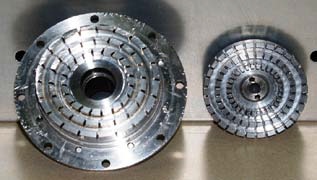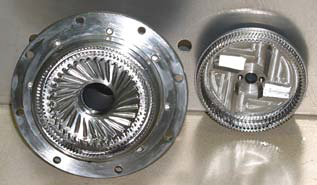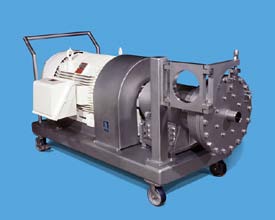Tech Report
Homogenization of submicron emulsions

Technology Brief
Submicron emulsions are traditionally prepared in rotor/stator mixers, colloid mills and high pressure homogenizers. Ultra-high shear mixers are the newest alternatives to conventional emulsification methods, delivering higher emulsion stability, improved throughput, easier maintenance, and/or lower cost.
Droplet size matters
In many industries, the challenge of making high quality submicron emulsions has never been more important. Fine emulsions make excellent carrier systems for a wide variety of active ingredients. Depending on the application, they improve texture, aesthetics, taste, rheology, shelf-life, or even cost. In short, the quality and stability of emulsions play a major role in refining the physical characteristics and effectiveness of numerous end products.
In an emulsion, big and small drops of the dispersed phase coexist throughout the continuous phase. The size distribution of these suspended droplets gives the best description of the emulsion and affects both stability and viscosity. Generally, the smaller the average particle size and the tighter the size distribution, the more stable the emulsion. This trend is relatively consistent among most emulsions whatever the end use and application; however there is no ideal droplet size that applies to all formulations. In other words, a 0.5- micron average droplet size may be considered a very stable level for one emulsion but not for another.
Sufficient mixing energy is required in order to create small droplets in an emulsion. For most systems, shear level has a direct relationship to droplet size reduction, but only within a specific limit. Many emulsions are shear-sensitive such that droplets start to coalesce beyond a certain level of shear. Apart from mixing intensity, several other factors affect emulsion stability including inherent properties of the dispersed phase and the continuous phase, temperature, presence and type of surfactant, etc.
Mixing equipment for emulsions
Depending on the shear level required by a particular formulation, manufacturers rely on rotor/stator mixers, colloid mills or high pressure homogenizers to produce stable submicron emulsions. Of the three, rotor/stator mixers are the most economical and the easiest to operate as well as maintain. These consist of a rotor that turns at 3,000-4,000 ft/min within a stationary stator. As the blades rotate, materials are continuously drawn into one end of the mixing head and expelled at high velocity through the openings of the stator. The differential speed and close tolerance between the rotor and stator generate high levels of hydraulic shear, promoting fast mixing and producing small droplets in emulsions.
When dealing with challenging emulsions that conventional rotor/stator mixers cannot successfully produce, manufacturers switch to higher energy devices. Homogenizers use high pressure to break down droplets by forcing the product through a narrow-gap valve into a lower pressure environment. The pressure gradient across the valve and the resulting turbulence and cavitation all contribute to reducing the size of dispersed droplets in the emulsion. The main drawbacks of these systems are cost, low throughput and tendency to clog. Intensive cleaning is also required after each run. Colloid mills, on the other hand, are essentially rotor/stator type mixing devices. A typical configuration consists of a conical or disk rotor and a stator; each piece has complementary grooves that serve as channels for the emulsion fluid to flow through. Fluid is pumped between the rotor/stator surfaces and hydraulic shear forces are generated within this gap. Like homogenizers, colloid mills deliver low flowrates and are time-consuming to clean.
Ultra-high shear mixers
New developments in rotor/stator technology offer a number of viable alternatives to traditional emulsifying equipment. Examples include the Ross X-Series, QuadSlot and MegaShear inline ultra-high shear mixers which operate up to 11,000 ft/min. These high-throughput, low-maintenance machines offer a more cost-effective way of improving mixing processes done on conventional rotor/stator mixers. In most applications, ultra-high shear mixers deliver better droplet size results compared to colloid mills. When used as a pre-mixer prior to homogenization, an ultra-high shear mixer can reduce the number of homogenizer passes required to reach the final size distribution and in some single pass requirements, it can eliminate the high pressure homogenizer entirely. High tip speeds and complex turbulent mixing patterns enable an ultra-high shear mixer to quickly produce submicron emulsions. Testing is recommended to confirm which rotor/stator design is best suited for a specific application.
Ross Ultra-High Shear Rotor/Stator Designs

X-Series
The X-Series head consists of concentric rows of intermeshing teeth. Product enters at the center of the stator and moves outward through radial channels in the rotor/stator teeth. The combination of high tip speed and extremely close tolerances subjects the product to intense shear in every pass. The gap between adjacent surfaces of the rotor and stator is adjustable for fine-tuning shear levels and flow rates.

QuadSlot
The QuadSlot mixing head is a multi-stage rotor/stator with a fixed clearance. This generator produces higher pumping rates and requires higher horsepower compared to an X-Series rotor/stator set running at similar speeds.

MegaShear
The MegaShear operates at the same tip speed as the X-Series and QuadSlot heads, but is even more aggressive in terms of shear and throughput levels. It consists of parallel semi-cylindrical grooves in the rotor and stator towards which product is forced by high velocity pumping vanes. Different streams are induced within the grooves and collide at high frequency before exiting the mix chamber.

Sample Application: Food Emulsions
A manufacturer of food emulsions replaced four colloid mills with one Ross X-Series Ultra-High Shear Mixer. The equipment upgrade greatly simplified their processing line - it reduced the cleaning, running, and balancing of four colloid mills into managing just one machine. The X-Series is cleaned and disinfected in place by performing a series of quick steps: pumping warm cleaning solution, rinsing and draining. This highly efficient cleaning procedure facilitated faster changeovers and longer intervals between cleaning cycles (longer production runs). After validating the CIP procedure according to GMP protocols, there is no need to dismantle the X-Series before or after cleaning.